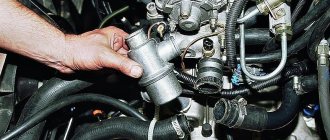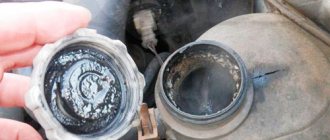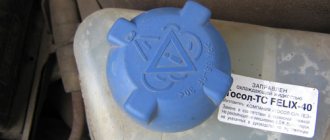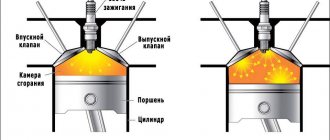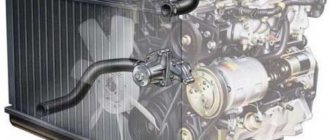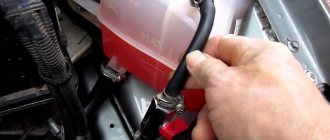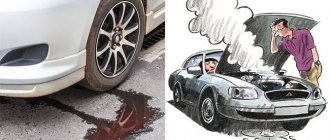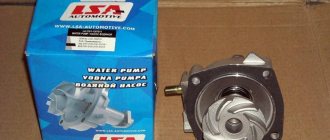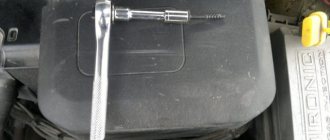The cooling system is an important part of any car. It does not allow the internal combustion engine to overheat, which prevents a huge number of serious problems. Also, air in the cooling system negatively affects the functioning of the heater in the car.
Therefore, every motorist should know how to bleed the cooling system. The process is not as complicated as it might seem at first glance. Therefore, even a novice driver can expel air from the cooling system without any problems. But first, find out more about the symptoms and causes of this problem.
How to determine engine overheating
The fact that this particular “trouble” occurred can be determined by several signs:
- Either the red indicator lights up on the dashboard, or the temperature gauge rises noticeably. This indicates the motor is heating up;
- The engine is boiling, and the heating air is cold;
- Experienced drivers will immediately determine that there is a fairly large temperature difference in the upper pipe along with the lower one.
The presence of air in the cooling system is not just an annoying nuisance, but a catastrophic fact that many inexperienced drivers simply may not notice or not pay due attention to. The consequences manifest themselves much later, when you have to stop in the most unexpected place, seeing steam escaping from the hood.
Many manufacturing companies, unfortunately, no longer provide temperature indicators with an arrow in their cars. Although sometimes the presence of such is not always able to protect drivers from such problems.
Why is aeration dangerous?
- An air lock present in the stove and cooling system of the VAZ-2109 will cause you a lot of trouble. Since the motor will warm up unevenly and there is a high probability of overheating due to poor cooling. The presence of air in the circuit prevents the coolant from circulating, which interferes with the heat extraction of antifreeze from the engine. An air lock also prevents the coolant from penetrating into the radiator, thereby causing the engine to overheat.
- Airing can also occur due to a car's heater not working for a long time. In this case, the antifreeze does not penetrate the heater radiator and remains cool, and the air does not heat up either.
What causes engine overheating?
When the temperature reaches its maximum value, along with the presence of a high level of pressure, a breakdown most often occurs in the intermediate partitions of the propulsion systems and their gaskets.
Not only the cooling system suffers from this, but also the lubrication system, gas distribution system and others.
- Significant overheating temperatures bend the head of the block where the cylinders are located. When overheating, this is the most common malfunction when the head becomes like a propeller.
- The head gasket eventually breaks down, causing coolant or oil to leak into the cylinders. After which, both scuffing and water hammer and similar “surprises” are possible, which lead to the vehicle being subjected to major repairs with very unpredictable costs.
To prevent the formation of an air plug, you should constantly carefully monitor the instrument readings.
Recommendations for prevention
It is much easier to avoid the appearance of air in the cooling system than to later eliminate the causes of engine overheating.
To do this, you need to follow the simplest recommendations:
- pour antifreeze into the expansion tank in a thin stream without using a wide funnel;
- periodically conduct a visual inspection of pipes, hoses and places of their attachment for leaks and damage, if any, replace the damaged element;
- regularly change the cooling system pump according to the manufacturer’s requirements;
- constantly monitor the level of working fluid in the tank and, if necessary, immediately top it up;
- check the oil level and if it increases, it is necessary to urgently carry out diagnostics, since this most likely means damage to the cylinder head gasket.
If symptoms of airiness occur, they can be easily eliminated by replacing worn parts and removing gas using simple methods that can be accomplished even by a novice driver in terms of complexity.
The formation of air in the cooling system and, as a result, overheating of the engine can be easily prevented by periodically inspecting the condition of the system, adding antifreeze in a timely manner and replacing the water pump and damaged parts in accordance with the manufacturer’s regulations.
Causes of traffic jams
There are certain types of malfunctions in which the system becomes airy. For example, its depressurization. It appears in different places. This may be a hose, pipe or fitting. Often the cause is damaged tubes.
- In addition to the fact that it can be caused by mechanical damage to some parts, they may simply wear out by this time. Also, the reason is often a decrease in the pressure level in the system.
- In the case when, after removing the air plug, signs of its presence appear again, this can only mean one thing, again the reason is depressurization of the system.
- Next, we are talking about repeating the diagnosis, as well as performing a visual inspection to identify the location of the damage.
Any of these reasons can cause harm to both the vehicle’s mechanisms and its components. Basically, the lack of normal cooling leads to overheating of the engine system and its operation, since wear-resistant characteristics can be reduced to a minimum.
In addition to the fact that its main parts are subject to deformation, parts of the seal may gradually fail. The most dangerous thing is if the engine seizes.
The presence of an air lock makes the stove inoperable due to poor circulation of antifreeze, without which there is no sufficient heat production.
In order to cope with such a problem, there are several effective methods that differ in both complexity of execution and method. The only similarity is that they use the fact that liquid is heavier than air.
avtoexperts.ru
It was only in the poem about charging that air and water were friends, they walked through life hand in hand and helped each other; in a car cooling system, the proximity of these two components usually leads to problems, sometimes very serious ones. Airing is an insidious disease, it occurs in the bowels of the car, is not noticeable to the eye, and is often difficult to determine, as if something is wrong in the car, but it is not immediately clear what. In addition, it often appears not as a result of the driver’s actions, but due to mechanical problems; the car owner may not even suspect that he has an air lock. However, if it is not always easy to diagnose the presence of air in the system, then removing it is a task that even novice motorists can cope with.
Places of air lock formation. Cooling system pipes for heating the throttle valve
Symptoms
The difficulty of diagnosing an air lock is due to the non-obviousness and subjectivity of the main parameters - engine cooling and the quality of the stove . If there is air in the system, then it will perform these functions worse than it should - the engine will overheat and the interior will not receive enough heat. However, this is not always noticeable to the eye. It’s good when the car has a coolant temperature sensor, it’s easier to see increased values, but modern cars don’t always have it. In addition, the sensor may also begin to malfunction due to air.
The efficiency of the stove does not measure anything at all; everything is based on the driver’s personal perception. Has it gotten colder in the cabin? Or maybe it just seems like it? In addition, no one uses the stove in the summer; for a whole six months one of the signs is irrelevant. Of course, if there is a lot of air in the system, then the deviation from normal operation will be too large, the problem will become obvious, but a small air lock may not be noticed immediately.
It will be noticeable to the driver if bubbling suddenly starts in the expansion tank - this is also a bad signal, so much air gets in that it comes out on its own, but it is very easy to determine the problem.
Bubbles in the expansion tank
Reasons for airing
The fight against air in the cooling system must be carried out simultaneously with the reason for its appearance there. Otherwise, the fight against the air will be reminiscent of a confrontation with a hydra - I removed one plug, two appeared. The most popular reason for air locks is improper replacement of coolant . Not everyone manages to replace the coolant without leaving air in the system. The air lock must be removed after each antifreeze change. It happens that air gets into the system even during trivial topping up, especially if you pour it in a wide stream into a narrow neck, and then immediately close the tank lid. But this is still rare.
Air lock in the cooling system
Other reasons include:
1. Depressurization of the system . A very insidious problem, the system itself is sucking air somewhere. This usually happens at joints. Pipes, fittings, hoses, radiators - there is a lot of this in any car. If a defect occurs at the junction, the pressure in the system perfectly acts as a pump and gradually sucks in air. By the way, depressurization does not always lead to leakage of antifreeze; it often happens that air enters the system, but the coolant level remains in place. How to fight? Looking for a weak joint is not difficult, but it is tedious.
2. Special cases of depressurization may be problems with the pump , which, due to breakdown or wear, begins to force air into the system, or a breakdown of the cylinder block gasket . In the second case, antifreeze begins to enter the engine, and exhaust gases rush into the cooling system. It is in this case that gurgling occurs in the expansion tank. Problems with the gasket are usually easy to notice (at least by the white smoke from the exhaust pipe), but a pump that begins to break down can cause a lot of trouble with minor problems before it reveals itself.
Blown cylinder head gasket
3. The air valve of the expansion tank plug has failed . It also happens that, as a result of a breakdown, the valve begins to work in the opposite direction - it does not relieve excess pressure from the system, but rather allows air to pass through. If in doubt, the plug can simply be replaced.
Disassembled expansion tank cap
Alas, the cause of airing is not always obvious; very often you have to look for the problem, especially if the whole issue is a violation of the tightness. But without this, dealing with air jams is practically useless.
Two ways to remove air
If the cause of airing is clear to you and you have eliminated it, then you can proceed to removing air from the system. Auto mechanics use many different methods, but they all boil down to two variations that are similar to each other - either push out the air using coolant, or expel it through active circulation . Which one to choose and how exactly to do it depends on the make of the car and the design of its cooling system. The principle diagram is the same for everyone, but there are differences in the nuances. Some cars have a special fitting for bleeding air, but some don’t, somewhere the filler plug is located on the expansion tank, and somewhere on the radiator, the majority of cars have one thermostat installed, and some have two, and so on Further. Therefore, today we will rather talk about the theoretical foundations of the methods, but you will need to think more about how to apply them on your car.
Ventilation hole
1. The first method is based on the fact that air is lighter than water and always tends upward, so you just need to remove it from the highest point by “squeezing it out” with antifreeze. The easiest case is if the car is equipped with a special fitting or valve for removing air . They are specially located in the upper pipes. You need to warm up the car so that the thermostat opens and air from the large circle can enter the small circle, and then unscrew the air bleed valve and keep it open until coolant flows out.
If there is no fitting, then its role may be the highest (and preferably small in diameter) pipe in the system. For example, some cars have a heated throttle assembly; there are usually thin pipes there and they are located high - they are well suited for this role. The principle is the same as with the fitting, only instead of unscrewing the fitting, we pull off the pipe, and when the coolant flows out, we quickly put it in place and tighten it. Yes, the accuracy of the work in this case is lower, the requirements for the dexterity and dexterity of the person performing the operation increases, and the loss of coolant will be noticeably higher, but still this is a relatively simple option if you correctly find the pipe to pull off.
Throttle valve heating pipes
2. The second method seems similar to the first, but everything is based on the active circulation of liquid through the system. It is necessary to jack up the part of the car where the expansion tank or radiator filler plug is located, remove the plug, open the heater tap (if there is one) and actively gas it, creating increased circulation. Air will begin to escape through the filler hole, you can see this by bubbles. When the bubbles run out, you need to add coolant to the level. The method is quite effective, but you need to be more careful with it, because it is easy to get burned on hot pipes or antifreeze. In addition, it is not always convenient to both gas and control the air output alone; you may need an assistant.
Experienced mechanics probably have their own variations of this operation; on the Internet we even came across descriptions where it was necessary to blow into the expansion tank, but, in general, the principle is similar, the choice depends only on convenience and the specific car model. You just need to think a little and remember the school physics course.
Author - Alexander Nechaev
First method
The actions are performed in the following order:
- The expansion tank is “released”, where cooling liquid is present. To do this, all elements are completely removed from it;
- Any of the pipes must be disconnected;
- The lid is removed from the tank and it is covered with a piece of cloth;
- Now you need to blow inside the tank to create a certain pressure. This will allow excess air to escape from the pipe;
- When the antifreeze starts to come out, the pipe is put on it and fixed with a clamp;
- The tank lid is closed, and all elements are installed in their places.
Method two
Algorithm:
- After starting, the engine is given about fifteen minutes to run, and then it turns off;
- The tank is “freed” from the elements;
- Without removing the cover, any of the pipes is disconnected. If there was excess air, it will come out;
- The pipe is put in place after the antifreeze liquid begins to flow.
Possible consequences
If a plug in the cooling system has been diagnosed, you should not put off removing it for too long. Impaired coolant circulation will very soon lead to dire consequences. Engine cooling efficiency drops significantly. Operation at high temperatures leads to accelerated wear of unit components. In extreme cases, naturally, there will be deformation and jamming. It will no longer be possible to do without major repairs, and this pleasure is extremely expensive.
The second is problems with the stove. Its functioning directly depends on the complete circulation of coolant. In the summer, a non-working stove will not create any inconvenience, but in winter it will become a real test for the driver. Also, operating a car with an air lock will lead to increased fuel consumption and damage to individual sensors. If you really want to save money, renovate now!
Third method
The algorithm for the third method of getting rid of an airlock comes down to the following:
- The front part of the car must be raised, for which the vehicle is placed on a small hill. The radiator cap, in this case, should be higher than other parts of the cooling system. The machine is secured with a hand brake and chocks under the wheels;
- The engine “runs” for about ten or fifteen minutes;
- The covers must be removed from the radiator and tank;
- The accelerator pedal must be pressed from time to time, while simultaneously replenishing the radiator with cooling liquid, monitoring the release of air from the system in the form of bubbles.
- This continues until the air is completely released. The stove turns on as much as possible. When the air becomes hot, it means the thermostat has opened fully and air has escaped.
Preparation for work
When a malfunction is identified, they begin to eliminate it.
Before you begin, you must:
- Find a suitable level place for the car. Take the necessary tools. A pair of wrenches, a Phillips screwdriver, and a jack are suitable for this.
- Turn off the engine and wait 10-15 minutes until it cools down.
- Check the drain plug. It should be tightly screwed.
- Carefully inspect the external condition of all units for mechanical damage. If any are found, the problem will be more difficult to solve.
This is what spots may look like if the cooling system is faulty.
Fourth method
If the car has a fan for cooling the system, which operates automatically, then re-gasping is not necessary. Simply letting the engine warm up is enough.
Then wait until the fan turns off. In this case, there is an increase in the movement of the cooling liquid, the circulation of which removes air from the system.
In this case, liquid is periodically added to the system so that airing does not recur.
This will reduce the risk of an air lock.
If you adhere to the rules of car operation, you can significantly reduce the risk of an air lock in the car. These recommendations look like this:
- compliance with the requirements of the service book for undergoing technical maintenance;
- checking the coolant level at least once a month;
- Fill only with recommended, high-quality coolant. Very often, if low-quality coolant is used, the system becomes airy.
Bottom line
It's time to take stock. The cooling system in every car plays a major role in providing the necessary cooling and maintaining the desired temperature of the internal combustion engine, and is also responsible for heating the interior. If you carry out scheduled maintenance on time and monitor the coolant level, then problems with the engine will not arise. After all, if airing in the system is not noticed and eliminated in time, this can lead to serious problems, in some cases to a major overhaul of the internal combustion engine.
